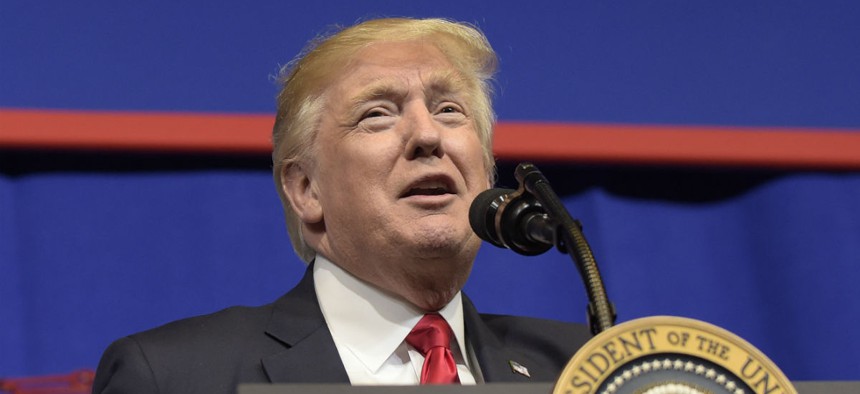Trump's 'Buy American' Order Draws Mixed Reviews from Contractors
Agencies are tasked with maximizing domestic product content and curbing waivers.
This story has been updated.
President Trump on Tuesday traveled to the Snap-On Tool manufacturing plant in Kenosha, Wis., to sign a previously announced executive order that tasks agencies and contractors with ramping up efforts to “Buy American” and “Hire American.”
Combined with a crackdown on unmerited high-level work visas and unfair trade practices, the order taps procurement specialists to propose contracting reforms to be assembled over 220 days by Commerce Secretary Wilbur Ross to create a “more muscular” Buy American policy, as a senior administration official told reporters Monday.
“It’s time,” Trump told the crowd on Tuesday, for the government to “aggressively promote and use American-made goods and to ensure that American labor is hired to do the job.” The purpose of the order is to require “federal agencies to strictly uphold our Buy American laws and minimize waivers and maximize Made in America content in all federal projects,” he said. “We will fully monitor, uphold and enforce our Buy American laws, which we haven’t done.”
Those older laws “require that when the federal government buys, builds or funds a project, domestic goods and products should be used,” the president said.
Trump, who toured the tool plant with several key White House staffers and his Treasury and Education secretaries, spoke in front of an American flag made of colored wrenches. He said his order “sends a powerful signal to the world that we will defend our workers, protect our jobs and, finally, put America first.” He said agencies must root out a past policy gutted by excess waivers and reckless exemptions.
Vowing to “use a sledgehammer” and to “level the playing field for our workers,” Trump promised to “make sure more products are stamped with those wonderful words ‘Made in the USA.’ ” He said America’s communities had lost 70,000 factories since China joined the World Trade Organization and that in November’s election, the electorate voted “to end the theft of American prosperity” that has been “lost to cheap subsidized and low-quality foreign goods.”
Trump had stressed the “America First Theme” during his presidential campaign, and in March 15 he traveled to Detroit to release guidance aimed at bringing more U.S. jobs to the auto industry.
The briefing official said the goal of updating the government’s decades-old Buy American laws is that “the culture immediately changes across the agencies. We have a lax enforcement, lax monitoring, lax compliance,” he said. “Every agency and department of government will conduct top-to-bottom assessments aimed squarely at cracking down on weak monitoring, enforcement, and compliance efforts, and at rooting out every single Buy American loophole.”
Reactions from the contracting industry blew hot and cold. “We like him putting the responsibility on each agency to delve into its own analysis of the impact,” Alan Chvotkin, counsel and executive vice president of the 400-member Professional Services Council, told Government Executive. He noted that how the Transportation Department buys products will differ from how the General Services Administration does it, and that information technology procurement differs from the purchase of commodities.
“Buy American usually applies more to goods than services, as in construction products,” Chvotkin added. “But the nature of federal procurement has changed over time, and more recently the government has been buying more of the services” that his member companies offer, “including provisioning of goods and services as part of the solution.”
The new crackdown on H-1B visas for high-skilled foreigners does not appear to be a problem for his members, but he cautioned that “making it more difficult to get H-1Bs doesn’t necessarily mean there are new opportunities available for U.S. citizens to fill those roles.”
Michael Fischetti, executive director of the National Contract Management Association, said by email, “Taking a more aggressive enforcement approach in this area is difficult to argue with, since it is law. However, meeting this mandate is tougher than ever, given the global nature of many consumer as well as government acquired products.”
The supply chain for many of today’s government requirements, including those for national defense, does not typically reside exclusively within the United States and thus is less readily influenced by the federal government than in the post-World War II years, he said. “Asking government to buy more like the commercial side at the same time is also more difficult, since ever-tighter management of the supply chain is required to ensure buy American provisions are properly implemented,” he added.
In buying IT systems, Fischetti noted, “Government contracting officers understand the concept of privity, meaning the government only has a contractual relationship with the prime contractor, not the subcontractor. Thus, implementing such provisions as ‘Buy American,’ fall to government contractors and their subs to manage.”




